
The brown-tail moth is a moth of the family Erebidae. It is native to Europe, neighboring countries in Asia, and the north coast of Africa. Descriptions of outbreaks, i.e., large population increases of several years duration, have been reported as far back as the 1500s. The life cycle of the moth is atypical, in that it spends approximately nine months as larvae (caterpillars), leaving about one month each for pupae, imagos and eggs. Larvae (caterpillars) are covered in hairs. Two red spots on the back, toward the tail, distinguish these species from other similarly hairy moth larvae. The winged adults have white wings and a hairy white body with a tuft of brown hair at the tip of the abdomen. Females lay one egg cluster, usually on the underside of a leaf of a host plant. The species is polyphagous, meaning that it feeds on many different species of trees, including pear, apple, maple and oak.
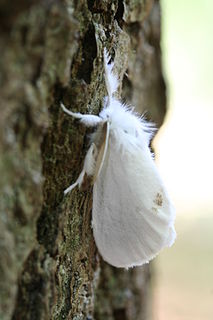
The yellow-tail, goldtail moth or swan moth is a moth of the family Erebidae. The species was first described by Johann Kaspar Füssli in 1775, and has commonly been placed within the related genus Euproctis. It is distributed throughout Europe to the Urals, then east across the Palearctic to Siberia and south to India and Sri Lanka.

Leeches are segmented parasitic or predatory worms that comprise the subclass Hirudinea within the phylum Annelida. They are closely related to the oligochaetes, which include the earthworm, and like them have soft, muscular, segmented bodies that can lengthen and contract. Both groups are hermaphrodites and have a clitellum, but leeches typically differ from the oligochaetes in having suckers at both ends and in having ring markings that do not correspond with their internal segmentation. The body is muscular and relatively solid, and the coelom, the spacious body cavity found in other annelids, is reduced to small channels.
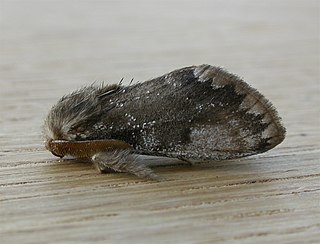
Euproctis marginalis, the margined browntail moth, is a moth of the family Erebidae. The species was first described by Francis Walker in 1855. It is found in Australia, including Tasmania.

Pyrausta is a speciose genus of moths of the family Crambidae. The genus was erected by Franz von Paula Schrank in 1802.

Pangrapta is a genus of moths in the family Erebidae. The genus was erected by Jacob Hübner in 1818.

Euproctis is a genus of tussock moths in the family Erebidae described by Jacob Hübner in 1819. Species are cosmopolitan, widespread throughout Palearctic, African, Oriental and Australian regions. Molecular phylogenetic studies indicate that the genus as presently understood comprises a large number of unrelated lineages, only a few of which have names, and is therefore in serious need of revision.

Somena is a genus of tussock moths in the family Erebidae. The genus was erected by Francis Walker in 1856.

Eucalyptus wandoo, commonly known as wandoo, dooto, warrnt or wornt, is a small to medium-sized tree that is endemic to the southwest of Western Australia. It has smooth bark, lance-shaped adult leaves, flower buds in groups of nine to seventeen, white flowers and conical to cylindrical fruit. It is one of a number of similar Eucalyptus species known as wandoo.
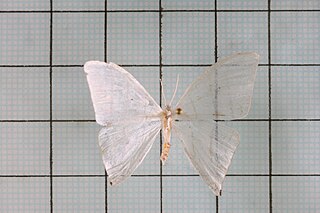
Ditrigona is a genus of moths belonging to the subfamily Drepaninae. The genus was erected by Frederic Moore in 1888.
Anonychia is a genus of moths in the family Geometridae described by William Warren in 1893 with type species Anonychia grisea. The genus was described using Nadagara grisea described by Arthur Gardiner Butler and genus Onychia described by Jacob Hübner and two more species added by Frederic Moore i.e. Anonychia lativitta and Anonychia violacea along with his Anonychia rostrifera. The name Anonychia is slightly altered from original Onychia by Hübner and Moore.
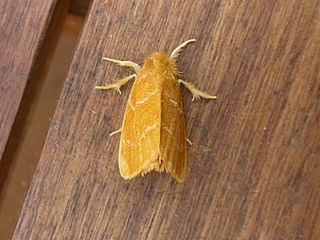
Euproctis lutea, the fresh-water mangrove itchy caterpillar, is a species of moth of the family Erebidae. It is found in northern Australia and New Guinea.
Mampava is a genus of snout moths. It was described by Émile Louis Ragonot in 1888.
Sybra pulverea is a species of beetle in the family Cerambycidae. It was described by Pascoe in 1865.
Euproctis fraterna is a moth of the family Erebidae first described by Frederic Moore in 1883. It is found in the Maldives, India, Sri Lanka and the Seychelles.
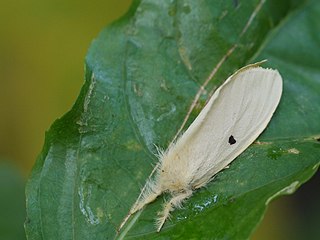
Euproctis lunata, the castor hairy caterpillar, is a moth of the family Erebidae. The species was first described by Francis Walker in 1855. It is found in India, Pakistan, Sri Lanka and Thailand.

Euproctis latifascia is a moth of the family Erebidae first described by Francis Walker in 1855. It is found in India, Sri Lanka and Taiwan.
Euproctis semisignata is a moth of the family Erebidae first described by Francis Walker in 1865. It is found in India and Sri Lanka.













